Sarkar N. (ed.) Human-Robot Interaction
Подождите немного. Документ загружается.


Collective Motion of Multi-Robot System based on Simple Dynamics
361
The stability of oscillatory motion is weaker than that of marching. Oscillatory clusters
often occur near the boundary between wandering, and the oscillation and marching
may coexist for some parameters.
3. Wandering: For non-zero d, the center of the cluster can wander quite irregularly, while
the lattice-like order inside the cluster persists. The mutual position of elements
rearranges intermittently according to chaotic changes in the direction of motion. We
call this behavior wandering. It occurs in flocks of birds, e.g., small non-migratory birds
like the sparrow.
4. Swarming: Beyond the wandering regime, we found more irregular motion, where the
regularity within the cluster fails, although the cluster persists. Compared to
wandering, the velocity of elements has a wide distribution, and the mobility of the
cluster is small, a behavior reminiscent of a cloud of mosquitoes.
Figure 3. The trajectories of the elements (dotted lines) and the center of mass (solid line)
obtained by numerical simulation. Each cluster consists of twelve motile elements (shown as
white circle). Typical types of collective motions are shown as: (a) marching, (b) oscillatory
(wavy), (c) wandering, and (d) swarming
Marching and oscillation form an ordered phase, while the others form a disordered phase.
In the ordered phase, elements behave as a regularly moving cluster which is stable against
perturbations by external force or small changes of kinetic parameters. This kind of stability
would be required for the grouping animals, too, because the cluster of traveling birds or
fishes should be structural stable. On the contrary, in disordered phase, the motion of
clusters become unpredictable, which would be beneficial for small animals to escape from
predators.
We refer to the transition between order and disorder as the marching/swarming transition.
We have examined the parameter dependence of the behavior, fixing the number of
elements, N = 10. In Fig. 4, we show characteristic behaviors in
τ
-
γ
and
τ
- a space. Fig. 4(a)
shows that the transition between marching and wandering is well defined and the
boundary occurs when
γ/τ ~ 20. Since γ is proportional to the relaxiation time in velocity,
γ/τ gives the ratio of characteristic time for heading reoriantation and velocity relaxiation of
individual elements. Fig. 4(b) shows that the transition line is approximately a ~
τ
-1/2
, which
seems to be nontrivial.
From similar plots, We obtain r
c
~
τ
and c ~
τ
as transition lines. The former can be
interpreted as the balancing of collision time between neighboring elements and heading
relaxiation time, and the later the balancing of velocity and heading relaxations. These
proportionalities suggest that we use dimensionless parameters. Futhermore, we expect that
the proportionalities would held for larger N>10, while the factors, i.e., the positions of
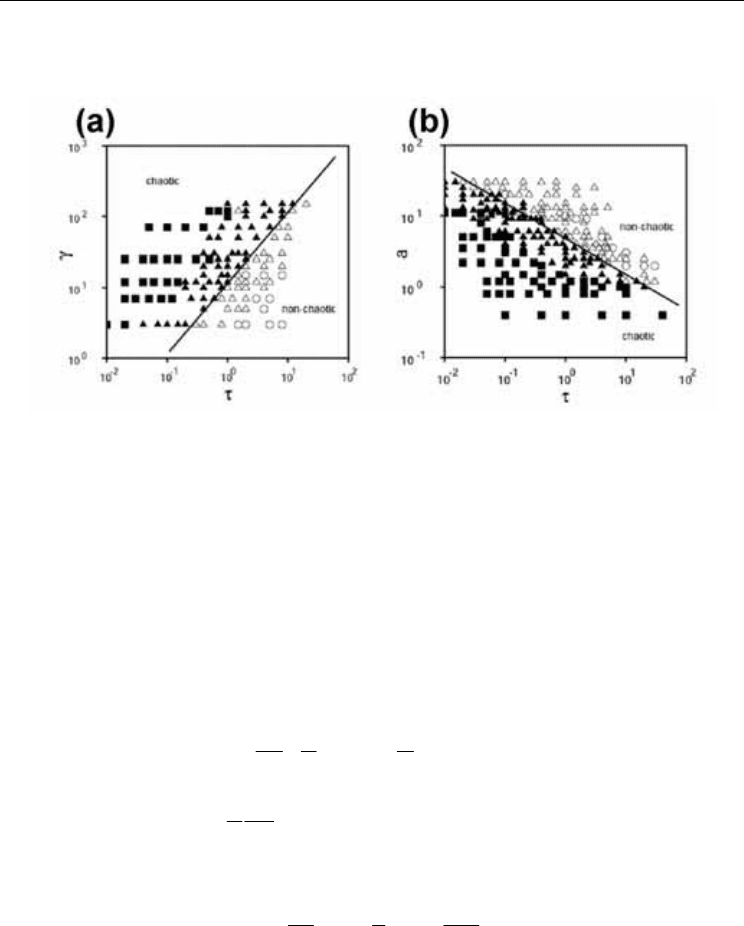
Human-Robot Interaction
362
transitions, might change. However, more specific transition lines, such as wandering/
swarming, are difficult to draw without introducing proper order parameters.
Figure 4. Parameter dependence of collective behavior. (a) γ versus τ. (b) a versus τ. Here,
white circles indicate marching, white triangles oscillation, black triangles wandering, and
black rectangles swarming
3.2 Dimensionless parameters
Next, we derive the dimensionless representation of our model and classify its behaviors. To
reduce the model equation to a dimensionless form, we rescale each variable by a
characteristic dimension: the characteristic length
c
rL ≡
0
is comparable to the size of each
individual, the steady state velocity
γ
/
0
aV ≡
of elements, and the characteristic time
arVLT
c
//
000
γ
=≡
. Introducing the non-dimensional variables v’, t’, r’ defined by
vVv
′
=
0
,
tTt
′
=
0
,
rLr
′
=
0
, we obtain the following non-dimensional equations of motion for the i-th
element (Shimoyama et al., 1996):
¦
≠
−+
′
−=
′
′
ij
ijijii
i
f
Q
nv
Rtd
vd
),
1
(
1
&
&&
&
α
(8)
).sin()sin(
1
ij
ij
ijii
i
J
td
d
P
θθθφ
θ
−+−=
′
¦
≠
(9)
We have three independent dimensionless parameters P,Q and R defined by:
,
τ
γ
a
r
P
c
≡
,
c
a
Q ≡
.
2
c
r
ma
R
γ
≡
(10)
The physical interpretation of each parameter is: P is the ratio of the typical time scale for
heading relaxation,
τ and the “mean free time”, r
c
γ
/a. Q is the ratio of the magnitude of the
motive force and the interaction force with neighbors. R is the ratio of the inertial force and
the viscous force, which is resembles a “Reynolds number” in fluid mechanics.
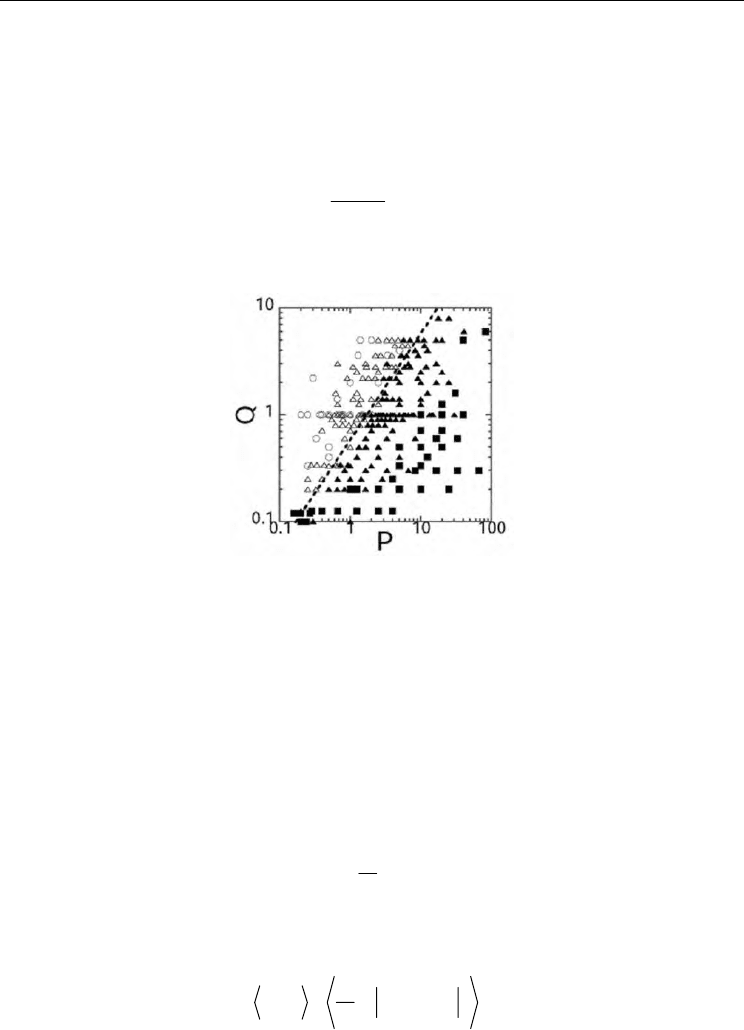
Collective Motion of Multi-Robot System based on Simple Dynamics
363
3.3 Phase diagram
We now review the numerical results, focusing on the marching/swarming transition, in the
viscous regime where R < 0.05. Consider the dependence of the marching/swarming
transition line in the phase diagram given in the previous section. At the transition line, we
obtained
γ
∗
∼τ
∗
, a
∗
~
τ
∗
-1/2
, c
∗
~
τ
∗
, and r
c
∗
~
τ
∗
, where
∗
signifies the boundary between the states.
Using a new dimensionless parameter defined by
QPG /≡
, these relations simplify to
.
*2*
**
*
const
a
cr
G
c
==
τ
γ
(11)
as shown in Fig. 5. All data from independent numerical simulations collapse onto the same
representation, with the transition line at G
∗
=const.
Figure 5. Phase diagram of collective motions in the viscous regime (R < 0.05) obtained by
independent numerical simulations by changing parameters (P versus Q). In the diagram,
white circles indicate marching, white triangles oscillation, black triangles wandering, and
black rectangles swarming
3.4 Degree of disorder
To characterize the different collective motions quantitatively, we need suitable measures of
disorder, i.e., disorder parameters. In ordered motions (marching and oscillating), the
trajectory of each element occupies a very limited region in velocity space. In chaotic
motions, both temporal fluctuations of cluster velocity and velocity deviations of elements
are large. Thus, we can define several disorder parameters. Letting the velocity of the cluster
at a moment t be,
¦
=
i
i
tv
N
tV ),(
1
)(
&
&
(12)
the fluctuation in velocity space can be evaluated by averaging the root mean square (r.m.s.)
velocity deviation over time;
()
.)()(
1
2
2
t
i
i
tVtv
N
v
¦
−≡Δ
&
&
(13)
We can define a similar parameter, the fluctuation of V(t) over time, by
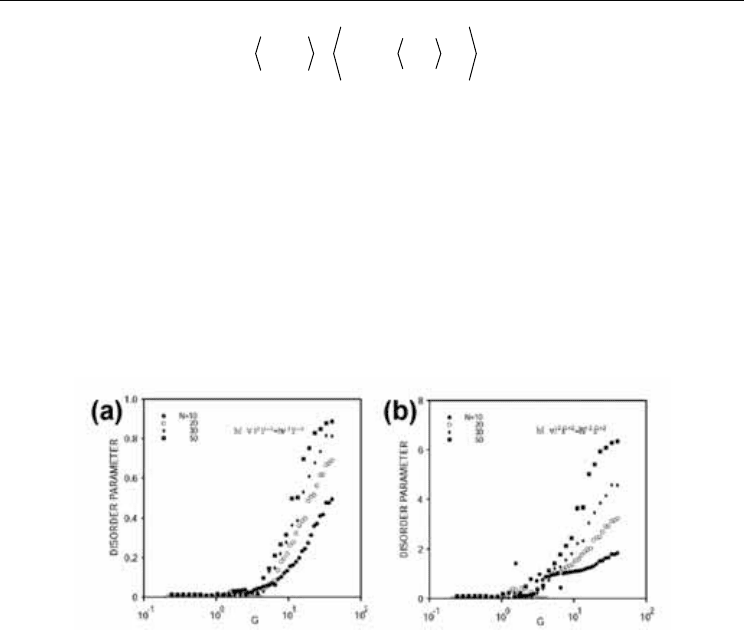
Human-Robot Interaction
364
()
.)()(
2
2
t
t
tVtVV
¸
¹
·
¨
©
§
−≡Δ
&&
(14)
Both quantities are zero in ordered motions and non-zero in disordered motions. In the
vicinity of the marching/swarming transition we calculated these quantities as a function of
G as shown in Fig. 6. In the plot, both quantities are normalized by the average cluster
velocity <V
2
>, and the square root of the values is shown. Using these parameters, the
order-disorder transition appears as a change in the disorder parameters. <(
Δ
V)
2
>
1/2
and
<(
Δ
v)
2
>
1/2
are a feasible way to characterize ordered vs. disordered motions. Above the
transition, the transition point, G
*
, <(
Δ
v)
2
>
1/2
/<(
Δ
V)
2
>
1/2
increases because the fluctuation of
cluster motion approaches the cluster velocity. Fluctuations inside the cluster increase
continuously as G increases. Swarming state corresponds to <(
Δ
V)
2
>
1/2
/<V
2
>
1/2
> 1 and
wandering and swarming states are continuous. It should be noted that the transition
becomes sharper as N increases. The transition point G
*
does not change. This suggests that
the same transition can be seen for larger size of groupings.
Figure 6. Characterization of the marching wandering transition in the viscous regime using
disorder parameters. (a) <(
Δ
V)
2
>
1/2
/<V
2
>
1/2
and (b) <(
Δ
v)
2
>
1/2
/<(
Δ
V)
2
>
1/2
. The plots are
made for several clusters of different size N from 10 to 50
3.5 Modification for formation control
Proposed model described above shows a variety of the group motions, however, it only
shows a regular triangular crystal formation and its boundary is round when we focus on
the formation of the group. In nature, we can observe other type of formations as well as
spherical structure observed in small fish school or the swarms of small insects. Large
migratory birds tend to form linear structure, which is considered to be hydrodynamically
advantageous. In robotics, there are some researches which focus on the formation control
of multi-robot (Balch & Arkin, 1998; Fredslund, 2002; Jadbabaie, 2003; Savkin, 2004), and
most of them introduce a kind of geometrical formation rules.
Our interest is to express not only round-shaped structure but also other formations by
modifying the above-mentioned model. In this section, modified model for formation
control is explained, especially focusing on form of linear structure. Note that we just treat
Newton’s equation of motion for particles and do not treat geometrical rules.
The direction sensitivity is controlled by the parameter d in Eq.(4). From the simple analysis,
we know that it is better to strengthen the direction sensitivity for linear formation. One of
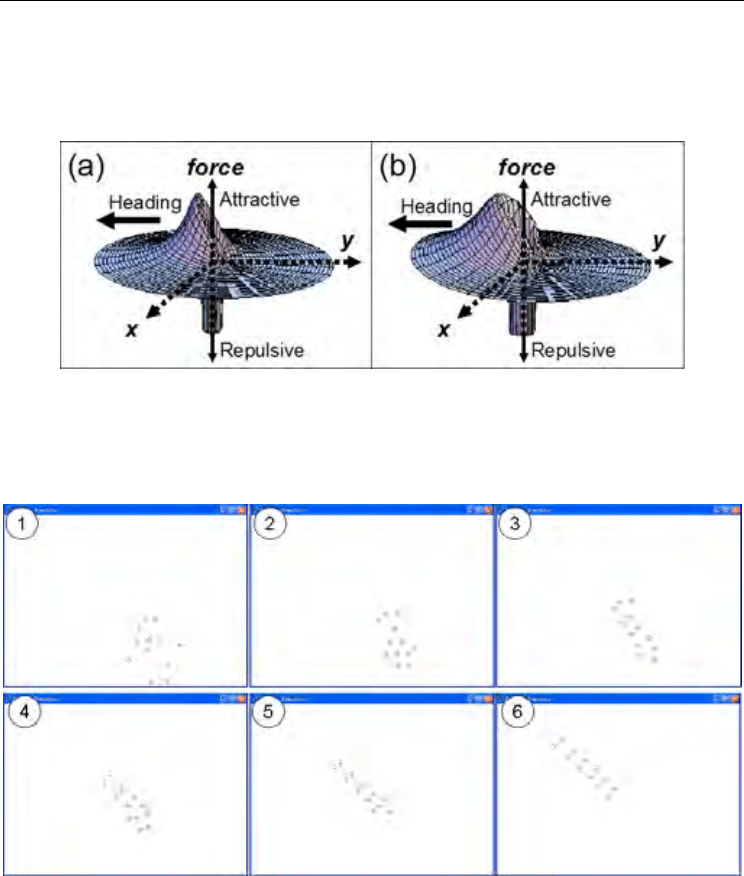
Collective Motion of Multi-Robot System based on Simple Dynamics
365
the simplest way to strengthen the direction sensitivity is to use d
2
instead of d in Eq.(4). But
for more drastic modification, we found it is more effective to replace r
c
with
cij
r⋅
α
instead
of strengthen d. Schematic images of interaction force are shown in Fig.7.
Figure 7. Images of interaction force in case of d=1, (a) r
c
=const., (b) r
c
=a
ij
x const
Fig.8 shows a typical behavior of the system based on the modified model. As you see, they
organize a double line structure. This formation is stable and robust to perturbation.
Figure 8. Self-organization of double line structure
We can also show that the angle between the forward direction and double line structure
can be controled independently by modifying direction sensitivity.
).cos(1
δα
+Φ+= d
ij
(15)
we can design the heading angle by Dž. Fig.9 shows the process that the double line structure
is organized, in which heading angle is controlled as Dž = Ǒ/6.
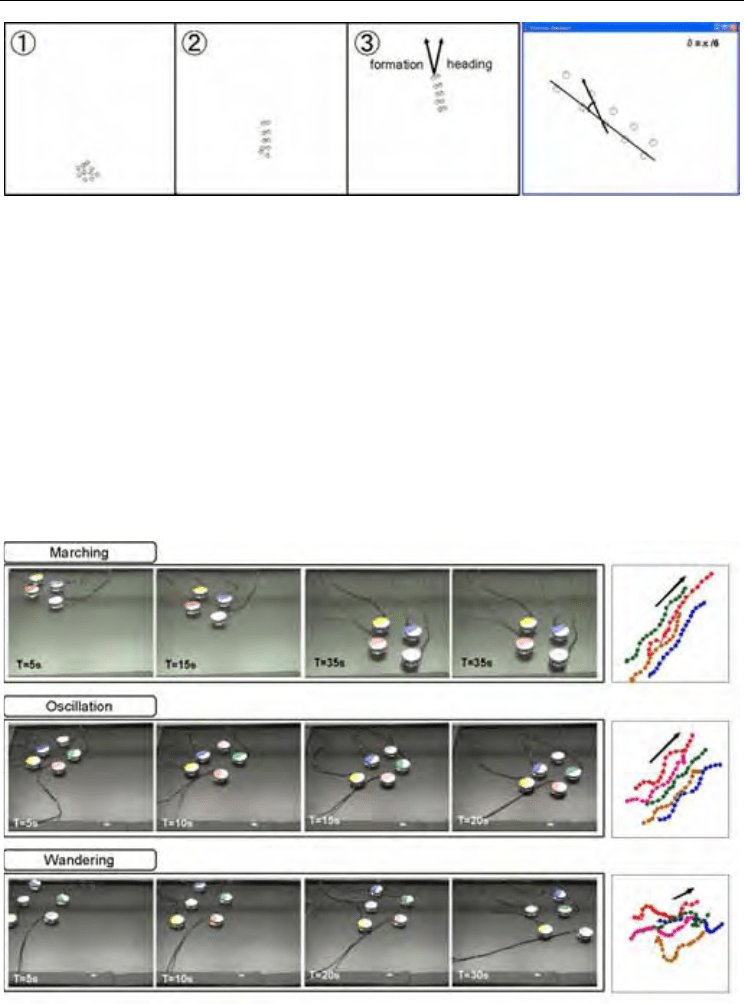
Human-Robot Interaction
366
Figure 9. Self-organization of double line structure in case of
δ
=
π
/ 6
4. Robot experiment
4.1 Collective behavior of the group
Performance of this system is also confirmed by the experiment of real robot system.
Miniature mobile robots Khepera, which is one of the most popular robots for experiments,
are used here. As the sensors on the robot are insufficient to measure the direction and the
distance between the robots, positions and directions of the robot are measured by the
overhead camera and each robot determines its behavior based on this information.
The model contains a degree of freedom for the heading. Khepera robot, however, has no
freedom for heading. So we divide the movement of the robots into two phases: the phase to
update the position, and the phase to update their directions. Fig. 10 shows the snapshot of
the experiment and the trajectories of the robots in case of "marching", "Oscillatory", and
"wandering."
Figure 10. Snapshots of the experiment in case of "marching", "oscillatory" and "wandering"
behaviour (pictures), and trajectories of the robots (plots)

Collective Motion of Multi-Robot System based on Simple Dynamics
367
4.2 Double line formation
The performance of the modified model is also confirmed by the robot experiment. The
condition of the experiment is same as previous section. Fig.11 shows the snapshot of the
experiment and the trajectories of the robots. We can see the robots organize double line
formation.
Figure 11. Snapshots of the experiment in case of “double line formation”
5. Summary
In this article, we proposed a mathematical model which show several types of collective
motions, and validated it. Firstly we constructed a model in which each element obeys the
Newton equation with resistive and interactive force and has a degree of freedom of the
heading vector which is parallel to the element axis, in addition to its position and velocity.
Performance of the model was confirmed by numerical simulation, and we obtained several
types of collective behavior, such as regular cluster motions, chaotic wandering and
swarming of cluster without introducing random fluctuations. By introducing a set of
dimensionless parameters, we formulated the collective motions and obtained the phase
diagram and a new dimensionless parameter G. Lastly, we referred to the behaviour of
extended model in which the anisotropy of the interaction force is modified, and showed the
group organizes the double line formation.
6. References
Aoki, I. (1980). An Analysis of The Schooling Behavior of Fish: Internal Organization and
Communication Process, Bull. Res. Inst. Univ. Tokyo, 12, pp.1-65.
Balch, T. & Arkin, R. C. (1998). Behavior-Based Formation Control for Multiagent Robot
Teams, IEEE Trans. on Robotics and Automation, Vol.14, No.6, pp.926-939.
Balch, T. & Parker, L. E. (2002). Robot Teams : From Diversity to Polymorphism, A K Peters Ltd,
ISBN:9781568811550
Bonabeau, E., Dorigo, M., & Theraulaz, G. (1999), Swarm Intelligence: From Natural to Artificial
Systems, Oxford University Press, New York, ISBN:0-19-513159-2
Breder, C. M. (1954). Equations Descriptive of Fish Schools and Other Animal Aggregations,
Ecology, 35, pp.361-370
Breder, C. M. (1976). Fish Schools as Operational Structures, Fish. Bull., 74, pp.471-502.
Cao, Y. U., Fukunaga, A. S. and Kahng, A. B. (1997), "Cooperative Mobile Robotics:
Antecedents and Directions, Autonomous Robots, 4, pp.7-27.
Doustari, M. A. & Sannomiya, N. (1992). A Simulation Study on Schooling Mechanism in
Fish Behavior, Trans. ISCIE, 5, pp.521-523.
Edelstein-Keshet, L. (1990). Collective motion, In: Lecture Notes in Biomathematics, Alt, W. &
Hoffmann, G., (Ed), pp.528-532.

Human-Robot Interaction
368
Fredslund, J. & Mataric, M. J. (2002). A General, Local Algorithm for Robot Formations, IEEE
Trans. on Robotics and Automation, Vol.18, No.5, pp.837-846.
Hunter, J. R.(1966). Procedure for Analysis of Schooling Behavior. J. Fish. Res. Board Canada,
23, pp.547-562.
Inoue, M. (1981). Fish school; behavior (in Japanese). Tokyo:Kaiyo-shuppan.
Jadbabaie, A., Lin, J. & Morse, A. S. (2003). Coordination of Groups of Mobile Autonomous
Agents Using Nearest Neighbor Rules, IEEE Trans. on Automatic Control, Vol.48,
No.6, pp.988-1001.
Niwa, H. (1994). Self-organizing Dynamic Model of Fish Schooling. J. of Theor. Biol., 171,
pp.123-136.
Ogren, P., Fiorelli, E. & Leonard, N. E. (2004). Cooperative Control of Mobile Sensor
Networks: Adaptive Gradient Climbing in a Distributed Environment, IEEE
Transactions on Automatic Control, Vol.49, No.8, 2004, pp.1292-1302.
Parker, L. E. (2003). Current Research in Multirobot Systems, Artificial Life and Robotics, vol.
7, pp.1-5.
Partridge, B. L. (1982). The Structure and Function of Fish Scholls. Sci. Am. 246, pp.90-99.
Savkin, A. (2004) Coordinated collective motion of groups of autonomous mobile robots:
Analysis of vicsek's model, IEEE Trans. on Automatic Control, Vol.49, No.6, pp.981-
983.
Shimoyama N., Sugawara K., Mizuguchi T., Hayakawa Y., Sano M. (1996). Collective
Motion of a System of Motile Elements, Phys. Rev. Lett., 79, pp.3870-3873.
Vicsek, T., Czirok, A., Ben-Jacob, E., Cohen I., & Shochet, O. (1995). Novel Type of Phase
Transition in a System of Self-Driven Particles. Phys. Rev. Lett., 75, pp.1226-1229.
Wilson, E. O. (1975). Sociobiology, Harvard.
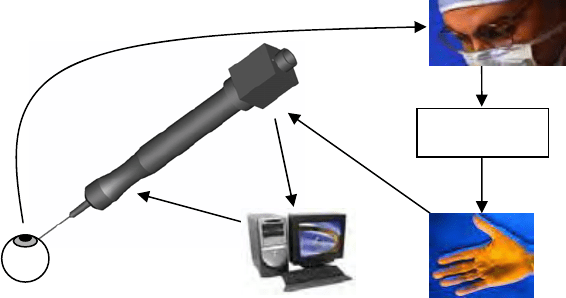
21
Modeling and Control of Piezoelectric Actuators
for Active Physiological Tremor Compensation
U-Xuan Tan
1
, Win Tun Latt
1
, Cheng Yap Shee
1
, Cameron Riviere
2
and Wei Tech Ang
1
1
Nanyang Technological University
2
Carnegie Mellon University
1
Singapore,
2
United States
1. Introduction
Humans have intrinsic limitations in manual positioning accuracy due to small involuntary
movements that are inherent in normal hand motion. Among the several types of erroneous
hand movements, physiological tremor is well studied and documented. Physiological
tremor is roughly sinusoidal, in the frequency band of 8 – 12 Hz, and measures about 50 μm
rms or more in each principal direction. Physiological hand tremor degrades the quality of
many micromanipulation tasks and is intolerable in certain critical applications such as
microsurgery and cell manipulation. In the human hand, humans are already in possession
of a high dexterity manipulator with an unbeatable user interface. Hence, instead of
replacing the human hand with a robotic manipulator, Riviere et al. [Riviere et al., 2003]
proposed a completely handheld ophthalmic microsurgical instrument, named Micron, that
senses its own movement, distinguishes between desired and undesired motion, and
deflects its tip to perform active compensation of the undesired component (Fig. 1).
Figure 1. Overview of Micron
Visuomotor
Control System
Noisy, Tremulous
Motion
Motion
Sensing
Visual Feedback
Micron
Vitreoretinal
Microsurgery
Estimation o
f
erroneous motion
Tip
manipulation for
active error
compensation
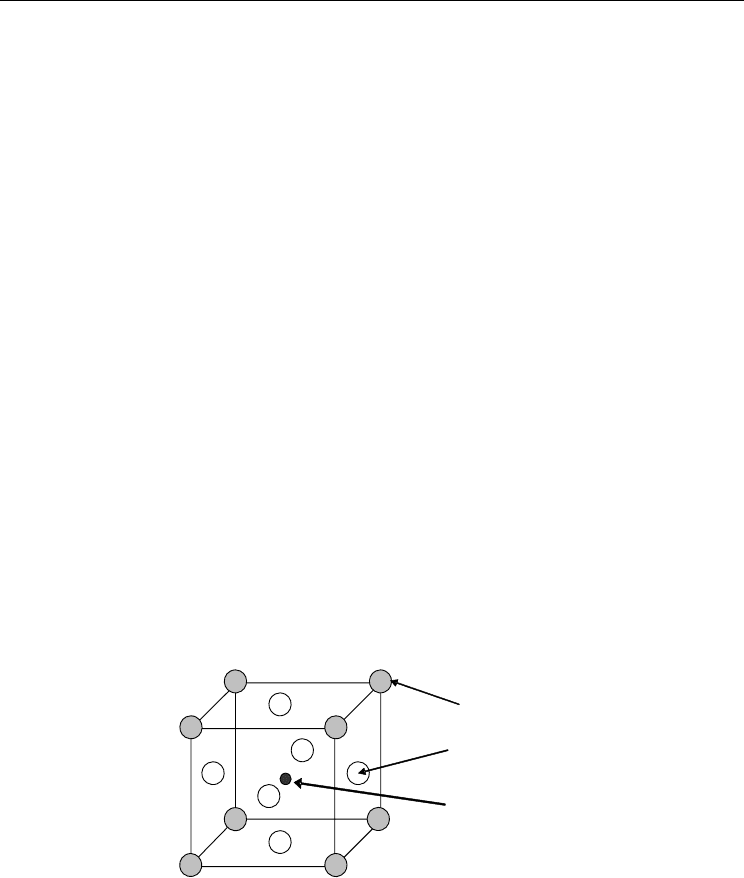
Human-Robot Interaction
370
This active compensation approach presents several technical challenges in the control of
the robotic mechanism that manipulates the intraocular shaft. The accuracy required can go
down to a few microns for applications like microsurgery. To achieve that, the controller
must be able to perform tracking control of the actuator to sub micron level. Physiological
tremor is typically 8 – 12 Hz. Controlling the actuator to accurately track a motion of about
10 Hz is beyond the system bandwidth of many actuators. In order to actively compensate
the tremor motion, real-time issue is another concern. Minimal phase difference is permitted
as phase difference will result in larger tracking error. Most controllers, which introduce
phase difference, are therefore not recommended. Thus, an open loop feedforward
controller is proposed. To make things even more challenging, tremor is not rate-
independent. The tremor frequency of a person modulates with type of motion and time.
Due to the high velocity and good resolution required, actuators involving smart materials
like piezoelectric are proposed. However, their hysteretic behavior makes control difficult.
In this chapter, the authors used the Prandtl-Ishlinskii (PI) hysteresis model to model the
hysteretic behavior. The PI hysteresis model is a simple model. Its inverse can be obtained
analytically, shortening the computational time and making it ideal for real-time
application. Since the PI operator inherits the symmetry property of the backlash operator, a
saturation operator is used to make it not symmetrical. The inverse model, also of the PI
type, is used as the feedforward controller. A slight modification is also proposed to account
for the one-sided characteristic of the actuator.
To accommodate human tremor’s modulating frequency behavior, a rate-dependent
hysteresis model is proposed. As the velocity or load increases, the slope of the hysteretic
curve at the turning point tends to 0 and then negative, creating a singularity problem. This
chapter also shows how the problem can be overcome by mapping the hysteresis through a
transformation onto a singularity-free domain where the inversion can be obtained.
2. Piezoelectric Actuators
Figure 2. A Crystal Unit Cell of PZT Ceramics
Piezoelectric ceramic has been of increasing interest due to the developments in precision
engineering and micro-positioning applications, especially in situations wherein precision,
high frequency, and compactness are needed. Piezoelectric ceramic is also playing an
increasing role in the medical industry as it is compatible with sensitive medical devices like
MRI. Choi et al. [Choi et al., 2005] used piezoelectric actuators for their microsurgical
instrument. One common example of piezoelectric ceramic is PZT ceramic. PZT is a solid
Pb
2+
O
2-
Zr
4+
or Ti
4+
